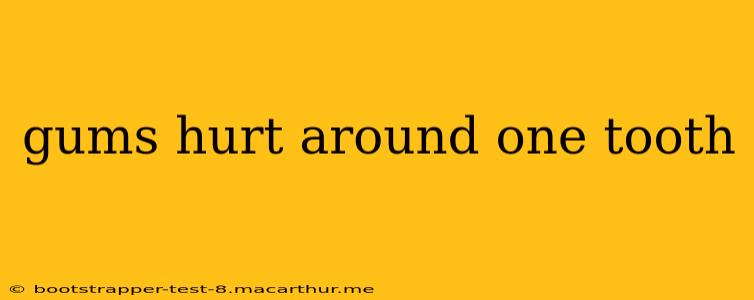Experiencing gum pain localized around a single tooth can be alarming, but understanding the potential causes can help alleviate anxiety and guide you toward appropriate treatment. This localized pain often points to specific dental issues, rather than generalized gum disease. Let's explore the common culprits and what you can do.
What Could Be Causing Gum Pain Around One Tooth?
Gum pain isolated to one tooth usually indicates a problem directly related to that tooth or its supporting structures. Here are some possibilities:
- Gum infection (gingivitis or periodontitis): While typically affecting multiple teeth, localized inflammation can occur, especially if food particles or plaque buildup is concentrated around a single tooth. This can manifest as redness, swelling, and tenderness.
- Abscess: A pocket of pus forms at the root of the tooth or in the gum tissue. This is usually extremely painful and requires immediate professional attention. Symptoms can include throbbing pain, swelling, and sensitivity to pressure.
- Periapical Abscess: This type of abscess forms at the tip of the tooth root. It's often caused by a severely infected tooth with pulp damage. Symptoms mirror those of a gum abscess but often include intense pain that radiates.
- Dental caries (cavities): Decay extending below the gum line can irritate the surrounding tissue, leading to localized gum pain and sensitivity.
- Trauma: Injury to the gum tissue from biting down hard on something, accidentally hitting your tooth, or undergoing a dental procedure might cause localized pain and swelling.
- Tooth impaction (partially erupted tooth): A partially erupted wisdom tooth or another tooth can irritate the surrounding gum tissue, causing pain and inflammation.
- Loose or damaged filling or crown: A cracked or loose filling or crown can create a space where bacteria can accumulate, leading to gum irritation and inflammation.
How Can I Tell If It's Serious?
Several factors suggest the need for urgent professional help:
- Severe pain: Intense, throbbing pain, especially if it radiates or keeps you awake at night.
- Swelling: Significant swelling of the gums or face.
- Fever: A high temperature often indicates a serious infection.
- Pus: The presence of pus (a yellowish or whitish fluid) is a clear sign of infection.
- Difficulty opening your mouth: This can indicate severe inflammation or infection.
What Should I Do If My Gums Hurt Around One Tooth?
Don't delay seeking professional help if you experience severe pain or any of the warning signs mentioned above. A dentist or periodontist can accurately diagnose the cause of your gum pain and recommend the appropriate treatment.
How Can I Prevent Gum Pain Around One Tooth?
Practicing good oral hygiene is paramount in preventing gum problems:
- Brush twice daily: Use a soft-bristled toothbrush and fluoride toothpaste. Focus on gentle but thorough brushing, paying close attention to the gum line.
- Floss daily: Flossing removes plaque and food particles from between teeth and along the gum line.
- Use mouthwash: An antimicrobial mouthwash can help reduce bacteria in the mouth.
- Regular dental checkups: See your dentist for regular checkups and professional cleanings to prevent and detect dental problems early.
- Maintain a healthy diet: A balanced diet low in sugary foods and drinks helps prevent tooth decay and gum disease.
What Home Remedies Can Help Soothe the Pain?
While home remedies can offer temporary relief from mild discomfort, they are not a substitute for professional dental care. You can try:
- Rinsing with salt water: This can help reduce inflammation and clean the affected area.
- Applying a cold compress: This can help reduce swelling.
- Over-the-counter pain relievers: Ibuprofen or acetaminophen can help manage pain and inflammation.
Remember, these are temporary measures. Persistent or worsening pain warrants immediate consultation with a dental professional.
Can Gum Disease Affect Only One Tooth?
While generalized gum disease (gingivitis and periodontitis) typically affects multiple teeth, localized inflammation can occur. Poor oral hygiene around a single tooth, a specific irritant, or an underlying dental problem can trigger localized gum inflammation.
How Is Gum Pain Around One Tooth Treated?
Treatment depends on the underlying cause. Options may include:
- Scaling and root planing: To remove plaque and tartar from below the gum line.
- Antibiotics: To treat infections.
- Root canal: To treat a severely infected tooth.
- Extraction: In cases of severe damage or infection.
- Repairing damaged fillings or crowns: To eliminate irritation caused by a damaged restoration.
This information is for educational purposes only and should not be considered medical advice. Always consult with a dental professional for diagnosis and treatment of any dental concerns.
